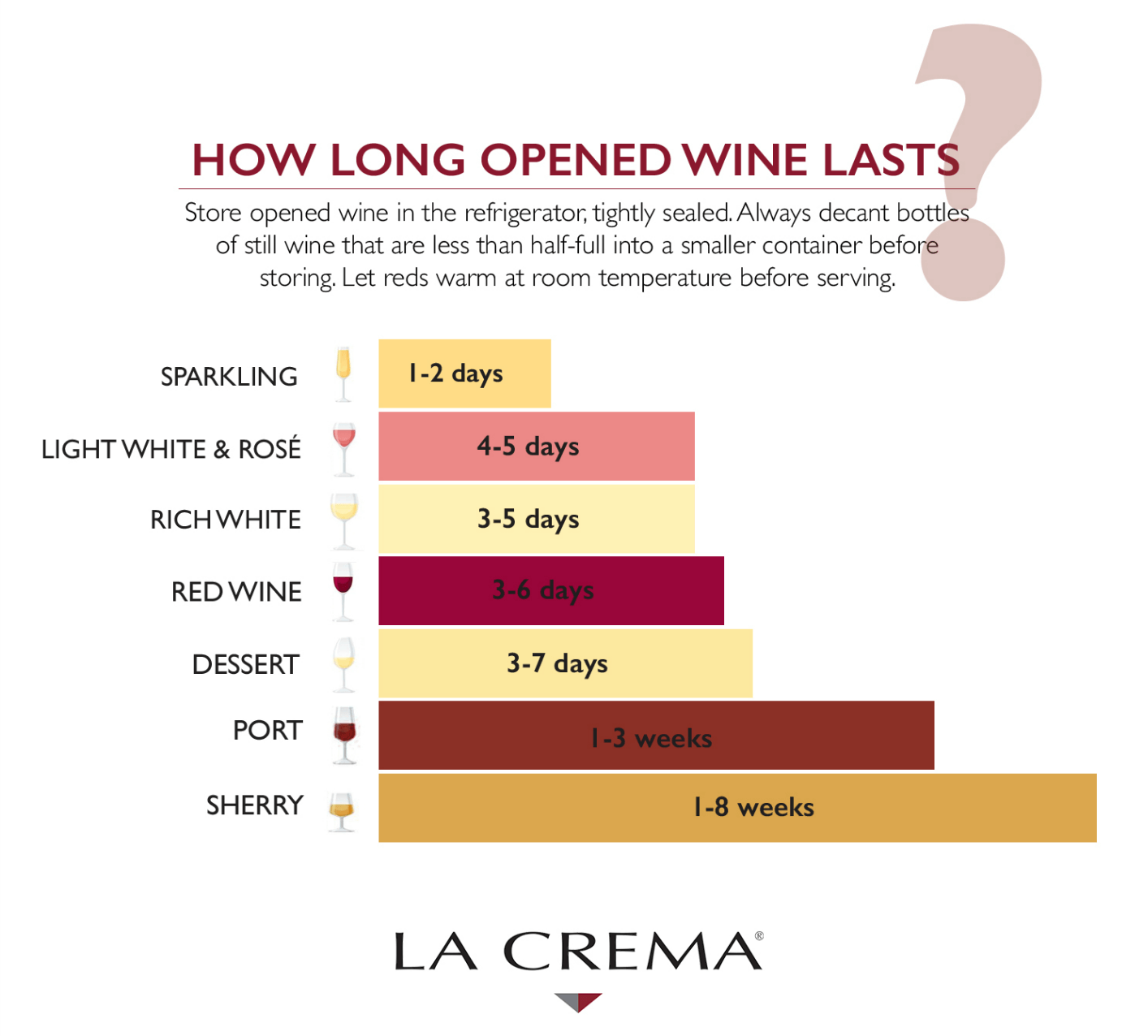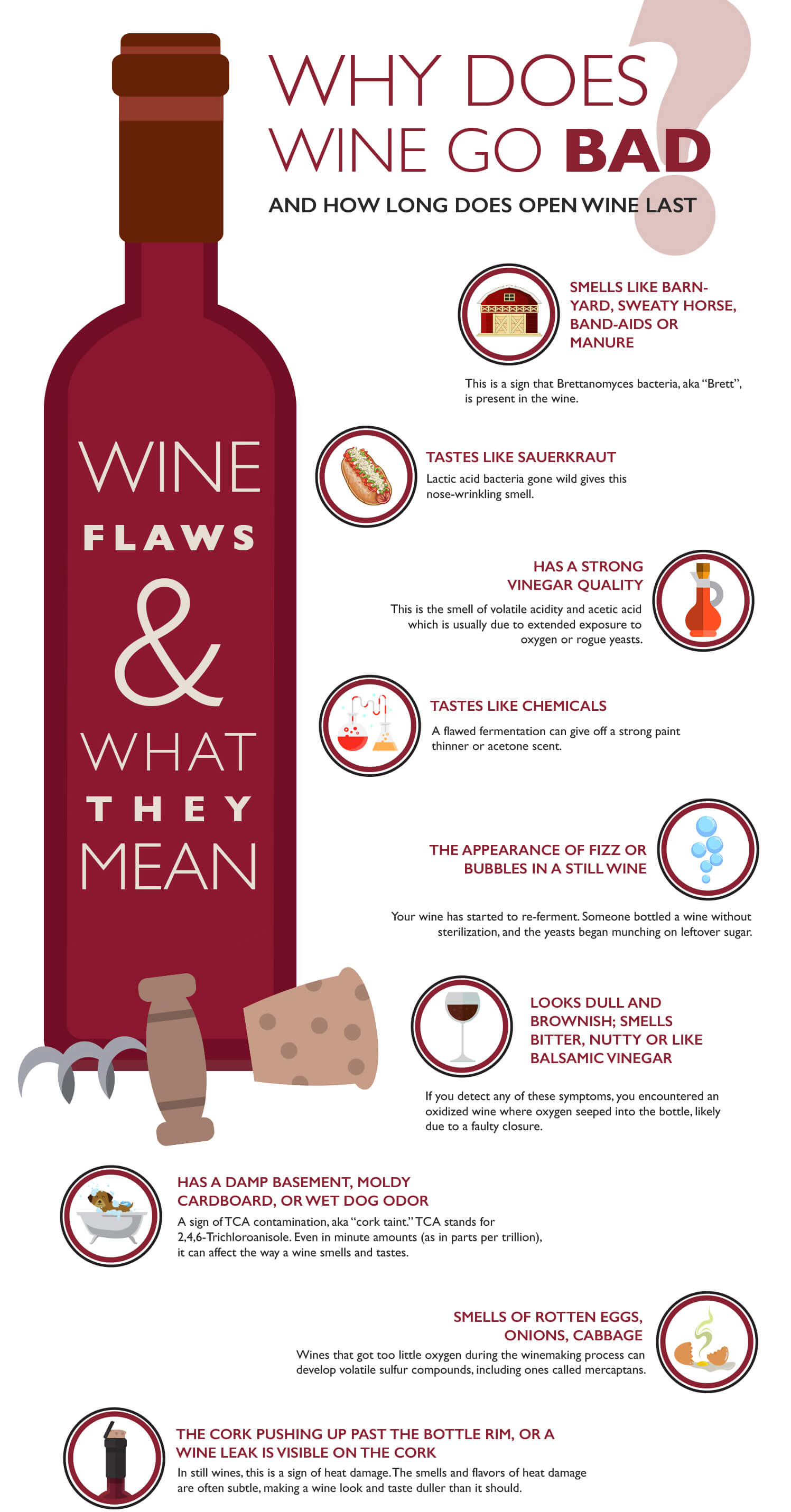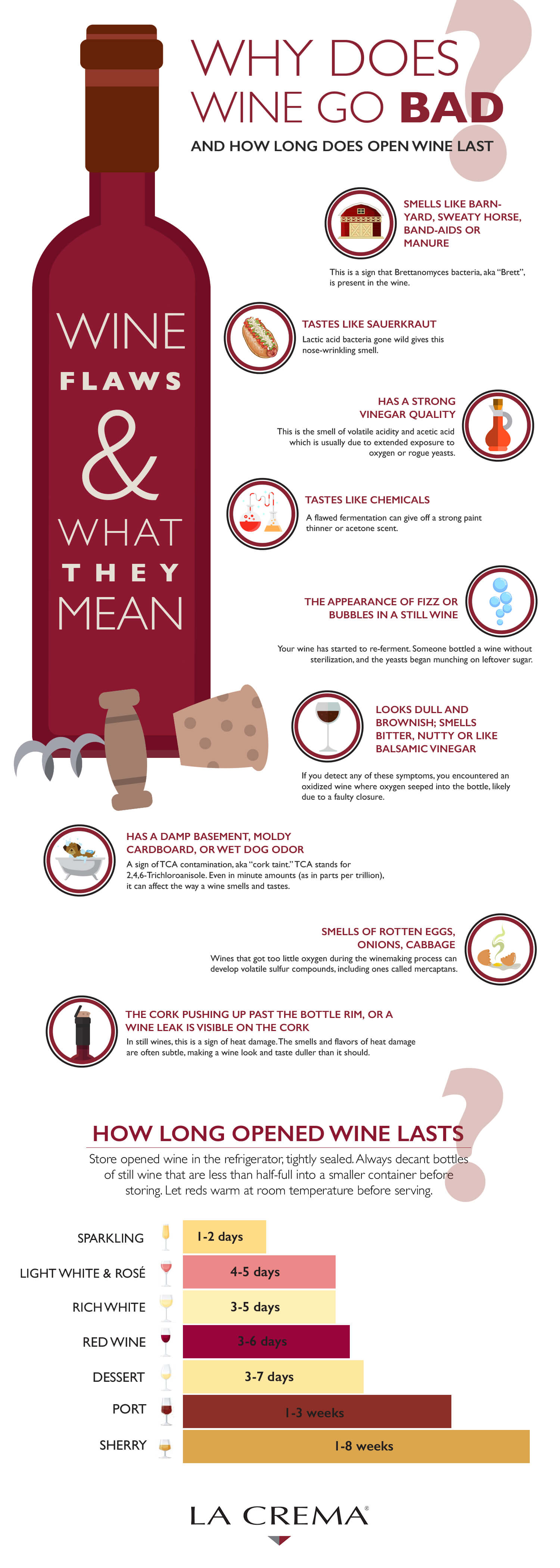Why Does Wine Go Bad and How Long Opened Wine Lasts
One of the most common questions that I get from students in my Introduction to Wine classes is about bad wine. People want to know, can wine go bad, why does wine go bad, how do you know if a wine has gone bad, and can you do anything to prevent it?
Why Does Wine Go Bad?
There are lots of reasons a wine can go bad. Poor bottling, microbial contamination and storage problems are just the beginning. Each of these issues has specific signs to look for, which makes it easier to tell a wine that’s gone bad from a wine that’s just not to your taste.
Microbial Contamination:
Wine is a product of fermentation, which involves yeast converting sugars into alcohol. However, once a bottle is opened, it becomes vulnerable to other microbes, such as acetic acid bacteria and wild yeasts, which can spoil the wine. These microbes thrive in environments where the alcohol and acidity are not high enough to inhibit their growth. They can cause the wine to develop off-flavors, become cloudy, or even spritz due to secondary fermentation. Proper sanitation of wine tools and the cork, as well as keeping the bottle tightly sealed, can reduce the risk of microbial contamination.
Heat and Light Exposure:
Wine is sensitive to environmental factors, especially heat and light. Exposure to high temperatures can accelerate chemical reactions in the wine, leading to a cooked or stewed flavor, often referred to as being “maderized.” Light, particularly UV light, can also cause wine to degrade through a process called “light strike,” which results in unpleasant aromas reminiscent of wet cardboard or a damp basement. This is why wine is typically stored in dark, cool places—preferably between 55-65°F (13-18°C)—to maintain its integrity.
Tannins and Acidity:
The structure of the wine itself plays a significant role in how quickly it goes bad. Wines with higher tannin levels, such as Cabernet Sauvignon or Syrah, tend to be more resilient after opening due to the preservative properties of tannins. Similarly, wines with high acidity, like Sauvignon Blanc or Riesling, are more resistant to spoilage because acidity acts as a natural preservative. However, even these wines are not immune to spoilage; they will eventually succumb to oxidation and microbial contamination if left open for too long. Understanding the structure of the wine can help you predict how long it will last after opening.
Oxidation:
A common reason that wine goes bad is that, after it was opened, no one drank it fast enough. (This is not usually a problem around my house, trust.) That’s because the moment you pull the cork on a bottle, powerful chemical changes start to occur in the wine. Oxygen rushes in and sulfur dioxide, which is added to nearly all wines as a preservative, dissolves into the air.
In time-limited doses, exposure to oxygen can make a wine taste more harmonious and expressive, turning up the volume on its flavors and smoothing them out. But the clock is ticking: in as little as two days, oxidation can spoil a wine and, soon enough, this process will turn it to vinegar. First, the fruity aromas disappear, then its flavors turn dull and flat, with a sharp or bitter edge, and the color changes. White wines darken and turn brownish; reds get lighter and browner. Soon, a wine that used to smell like apples or cherries may smell like vinegar or cider.
How To Tell if Your Wine Has Gone Bad
Appearance:
One of the first indicators that your wine may have gone bad is a noticeable change in its color. Red wines, for instance, might develop a brownish hue, while white wines can turn a darker yellow or even amber. These color changes occur due to oxidation, which affects the wine’s pigments. Additionally, if you see any unusual cloudiness or sediment that wasn’t originally there, this could be a sign of microbial activity or that the wine has undergone an undesirable chemical change. While some sediment is normal in aged wines, excessive or unexpected amounts may indicate spoilage.
Smell:
The aroma of wine is a strong indicator of its condition. A wine that has gone bad often emits off-putting odors that are hard to miss. If you detect a smell similar to vinegar, this suggests that the wine has oxidized too far and acetic acid has formed. Another common spoilage odor is that of wet cardboard or mold, which could indicate exposure to cork taint. If your wine smells unusually sweet, like sherry or caramel, this could also signal that it has oxidized beyond an enjoyable state, particularly in white wines.
Taste:
Tasting the wine is the most definitive way to tell if it has gone bad. Spoiled wine often tastes flat and lacks the vibrant flavors it once had. It may have a sour or overly acidic taste, resembling vinegar, which is a result of acetic acid formation. Some wines may develop a bitter or metallic taste, particularly if they have been exposed to too much air. Additionally, wine that has gone bad might taste overly sweet or syrupy, losing its original balance and complexity. If the wine tastes off in any of these ways, it’s a clear sign that it’s no longer good to drink.
Signs Your Wine has Gone Bad
- Smells like barnyard, sweaty horse, Band-Aids or manure: Brettanomyces, aka “Brett”, in sommelier shorthand, is a bacteria that, in small doses, is not necessarily unpleasant. Left unchecked, wine becomes undrinkable.
- Tastes like sauerkraut: Lactic acid bacteria gone wild gives this nose-wrinkling smell.
- Has a strong vinegar quality: This is the smell of volatile acidity and acetic acid, which usually develops in wine after exposure to oxygen. But rogue yeasts can create this flaw in the winery.
- Has a damp basement, moldy cardboard, or wet dog odor: A sign of TCA contamination, aka “cork taint”. TCA stands for 2,4,6-Trichloroanisole, which is a harmless, potent-smelling compound that most often occurs when chlorine-based cleaners come into contact with wood. Even in minute amounts (as in parts per trillion), it can affect the way a wine smells and tastes. If present in a barrel or winery equipment, entire lots of wine can be affected– meaning the cork is not always the culprit.
- Smells of rotten eggs, onions, cabbage: Wines that got too little oxygen during the winemaking process can develop volatile sulfur compounds, including ones called mercaptans. There’s no mistaking this flaw, even if you’ve never smelled a rotten egg. These wines are said to be “reduced,” meaning it was fermented without enough oxygen. Fortunately, this flaw often disappears shortly after the wine is opened. If it doesn’t, you can add something copper to your glass (such as a pre-1982 penny), which reacts with sulfur compounds and can magically eliminate the stinky smell.
- Tastes like chemicals: A flawed fermentation can give off a strong paint thinner or acetone scent. Sadly, nothing can help make a wine with this flaw taste better.
- Looks dull and brownish; smells bitter, nutty or like balsamic vinegar: If you detect any of these symptoms, you’re encountering oxidized wine, probably from a faulty closure. Oxygen seeped in and ruined it. Oxidation happens eventually to all opened wine.
- The appearance of fizz or bubbles in a still wine: Whoops, your wine has started to re-ferment. Someone bottled a wine without sterilization, and the yeasts began munching on leftover sugar.
- You notice the cork pushing up past the bottle rim, or a wine leak is visible on the cork: In still wines, this is a sign of heat damage. The smells and flavors of heat damage are often subtle, making a wine look and taste duller than it should. Just one day sitting in a hot delivery truck can damage a wine, even if it doesn’t leave visible evidence.
How Long Does Wine Last After it is Opened?
How to store opened wine without it going bad depends on the type of wine and how you store it. The graphic below breaks it down. Generally, the lighter the wine, the faster it goes bad. Tannins in wine help preserve them as does alcohol—which is why robust reds and fortified wines last longest. Richly sweet dessert wines will also stay fresh longer than dry varietals.

Tips to Extend the Life of Your Opened Wine
My go-to method of slowing down the spoilage of opened wine—both red and white—is to decant it into as small a container as possible and stick it in the fridge. I keep a few empty half-bottles (375ml) and their corks handy for this, but any old jar will do (just make sure it doesn’t still smell like kimchee or barbecue sauce or whatever you last had in your fridge). Presto! This step roughly doubles the shelf life of wine.
“Even reds?” you’re asking. Yes, even reds. The bacteria that turn wine into vinegar (acetic acid, to wine chemistry geeks) feed on oxygen. By exposing the wine to less oxygen, you’re starving the bacteria and slowing down spoilage. They also multiply like crazy at room temperature, so chilling the wine keeps their party to a dull roar.
Of course, there are lots of gadgets out there claiming to preserve wine, ranging from plastic vacuum pumps to spray cans of nonreactive gas. In my experience, with one giant exception, none of these make a huge difference. I recommend that, if you do pump or gas your wine, you also store it in the fridge.
The shining exception to these devices is the Coravin, which is easily the most effective—and expensive—tool ever invented to solve the problem of leftover wine. With Coravin, you don’t actually open the wine at all—you extract it through the cork via a fine needle, which also pumps argon gas into the bottle as a preservative. You can dole out glasses of wine over a period of months from a bottle, with no notable difference in freshness. I’ve enjoyed white wines that were first poured via Coravin more than a year prior, then stored at room temperature, and they still tasted juicy and vibrant. At parties, I sometimes let guests have sips from several “Coravinned” bottles, then pick the wine they like best.
Remember: It can be tricky to decipher whether a bottle has gone bad from something that just isn’t your taste. At the end of the day, if the smell and taste aren’t to your liking, listen to your senses. This could be due to a poor pairing or perhaps the type of wine and where it’s from just isn’t pleasing your palate. At the end of the day, you should always drink wines you enjoy.
Can Unopened Wine Go Bad?
Unopened wine can last for years, depending on the type, quality, and storage conditions. Most wines are best enjoyed within a few years, but some, especially high-quality reds, can improve with age if stored properly. However, even the best wines will eventually decline over time, as wine is a natural product.
Factors That Can Cause Unopened Wine to Go Bad
Unopened wine can spoil due to temperature fluctuations, which can cause premature aging and off-flavors. Light exposure—particularly UV light—can degrade the wine’s chemical structure, leading to “light strike.” Additionally, improper humidity levels can dry out the cork, allowing air to seep in and oxidize the wine, or cause mold growth if too humid.
Signs Your Unopened Wine Has Gone Bad
Signs of spoilage in unopened wine include a pushed-up cork, which suggests heat damage, and leaking wine around the cork, indicating a compromised seal. Discoloration—such as red wine turning brown or white wine darkening—can also signal that the wine has aged improperly or oxidized.
Proper Storage to Extend Longevity
To prevent unopened wine from spoiling, store it in a cool, dark place with a consistent temperature between 55-65°F (13-18°C). Bottles with cork closures should be stored on their side to keep the cork moist. Avoid areas with temperature fluctuations, such as kitchens, to ensure your wine stays in prime condition.
Enjoyed this post? Pin our infographic or click to download the PDF.
FAQs
Why does wine go bad after opening?
Wine goes bad primarily due to oxidation. Once exposed to air, the wine’s chemical structure changes, leading to off-flavors and spoilage.
What are the signs that wine has gone bad?
Signs include changes in color, unpleasant odors (like vinegar or wet cardboard), and a flat or sour taste. Bubbles in still wine can also indicate spoilage.
Can I prevent wine from going bad after opening?
Yes, store opened wine in the fridge and minimize its exposure to air by using a smaller container or a vacuum seal. This slows down oxidation.
What happens if I drink bad wine?
Drinking bad wine isn’t harmful but can be unpleasant. The wine will taste off, with sour or flat flavors, but it won’t make you sick.
Can wine spoil in the refrigerator?
Yes, even in the refrigerator, wine can spoil if left too long. However, refrigeration slows down the spoilage process, extending the wine’s freshness.
Can bad wine be saved or fixed?
Once wine has gone bad due to oxidation or contamination, it cannot be fixed. The best course of action is to prevent spoilage by proper storage.






Comments